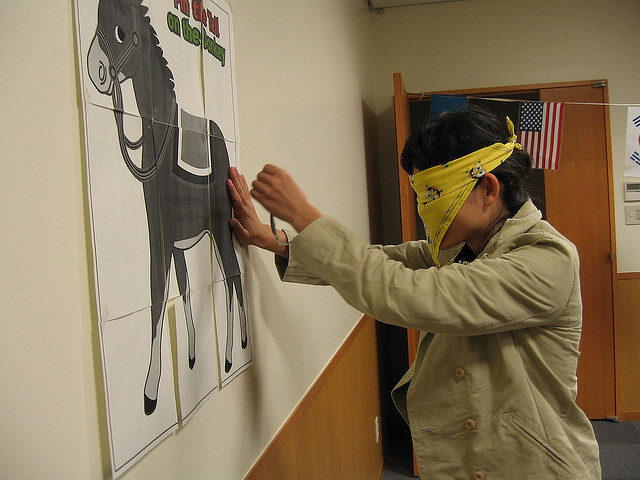Archive for May, 2014
The Complexity Conundrum
 In school the problems you were given weren’t really problems at all. In school you opened the book to a specific page and there, right before you in paragraph form and numbered consecutively, was a neat row of “problems”. They were fully-defined, with known inputs, a formal equation that defined the system’s response, and one right answer. Nothing extra, nothing missing, nothing contradictory. Today’s problems are nothing like that.
In school the problems you were given weren’t really problems at all. In school you opened the book to a specific page and there, right before you in paragraph form and numbered consecutively, was a neat row of “problems”. They were fully-defined, with known inputs, a formal equation that defined the system’s response, and one right answer. Nothing extra, nothing missing, nothing contradictory. Today’s problems are nothing like that.
Today’s problems don’t have a closed form solution; today’s problems don’t have a right answer. Three important factors come into play: companies and their systems are complex; the work, at some level, is always new; and people are always part of the equation.
It’s not that companies have a lot of moving parts (that makes them complicated); it’s that the parts can respond differently in different situations, can change over time (learn), and the parts can interact and change each others’ response (that’s complex). When you’re doing work you did last time, there’s a pretty good chance the system will perform like it did last time. But it’s a different story when the inputs are different, when the work is new.
When the work is new, there’s no precedent. The inputs are new and the response is newer. Perturb the system in a new way and you’re not sure how it will respond. New interactions between preciously unreactive parts make for exciting times. The seemingly unconnected parts ping each other through the ether, stiffen or slacken, and do their thing in a whole new way. Repeatability is out the window, and causal predictability is out of the question. New inputs (new work) slathers on layers of unknownness that must be handled differently.
Now for the real complexity culprit – people. Companies are nothing more than people systems in the shape of a company. And the work, well, that’s done by people. And people are well known to be complex. In a bad mood, we respond one way; confident and secure we respond in another. And people have memory. If something bad happened last time, next time we respond differently. And interactions among people are super complex – group think, seniority, trust, and social media.
Our problems swim with us in a hierarchical sea of complexity. That’s just how it is. Keep that in mind next time you put together your Gantt chart and next time you’re asked to guarantee the outcome of an innovation project.
Complexity is real, and there are real ways to handle it. But that’s for another time. Until then, I suggest you bone up on Dave Snowden’s work. When it comes to complexity, he’s the real deal.
Image credit – miguelb.
The Illusion of Planning
Planning is important work, but it’s non-value added work. Short and sweet – planning is waste.
Lean has taught us waste should be reduced, and the best way to reduce waste from planning is to spend less time planning. (I feel silly writing that.) Lean has taught us to reduce batch size, and the best way to reduce massive batch size of the annual planning marathon is to break it into smaller sessions. (I feel silly writing that too.)
Unreasonable time constraints increase creativity. To create next year’s plan, allocate just one for the whole thing. (Use a countdown timer.) And, because batch size must be reduced, repeat the process monthly. Twelve hours of the most productive planning ever, and countless planning hours converted into value added work.
Defining the future state and closing the gap is not the way to go. The way to go is to define the current state (where you are today) and define how to move forward. Use these two simple rules to guide you:
- Do more of what worked.
- Do less of what didn’t.
Here’s an example process:
The constraint – no new hires. (It’s most likely the case, so start there.)
Make a list of all the projects you’re working on. Decide which to stop right now (the STOP projects) and which you’ll finish by the end of the month (the COMPLETED projects). The remaining projects are the CONTINUE projects, and, since they’re aptly named, you should continue them next month. Then, count the number of STOP and COMPLETED projects – that’s the number of START projects you can start next month.
If the sum of STOP and COMPLETED is zero, ask if you can hire anyone this month. If the answer is no, see you next month.
If the sum is one, figure out what worked well, figure out how to build on it, and define the START project. Resources for the START project should be the same as the STOP or COMPLETED project.
If the sum is two, repeat.
Now ask if you can hire anyone this month. If the answer is no, you’re done. If the answer is yes, define how many you can hire.
With your number in hand, and building on what worked well, figure out the right START project. Resources must be limited by the number of new hires, and the project can’t start until the new hire is hired. (I feel silly writing that, but it must be written.) Or, if a START project can’t be started, use the new resource to pile on to an important CONTINUE project.
You’re done for the month, so send your updated plan to your boss and get back to work.
Next month, repeat.
The process will evolve nicely since you’ll refine it twelve times per year.
Ultimately, planning comes down to using your judgment to choose the next project based on the resources you’re given. The annual planning process is truly that simple, it’s just doesn’t look that way because it’s spread over so many months. So, if the company tells its leaders how many resources they have, and trusts them to use good judgment, yearly planning can be accomplished in twelve hours per year (literally). And since the plan is updated monthly, there’s no opportunity for emergency re-planning, and it will always be in line with reality.
Less waste and improved quality – isn’t that what lean taught us?
A Viral Infection Of Alignment And Consensus
 Alignment is all the rage. The thinking goes: If we’re all pulling in the same direction, we’ll get their faster. There’s truth to that – the boat does go faster with more oars and more backs pulling on them. And as long as the boat’s heading in the right direction, alignment holds water. But here’s the dark side – while we’re all pulling on our own oar, we’re all sitting in the same boat. And when the boat is scuttled by a fast moving storm, we all go down together – in alignment.
Alignment is all the rage. The thinking goes: If we’re all pulling in the same direction, we’ll get their faster. There’s truth to that – the boat does go faster with more oars and more backs pulling on them. And as long as the boat’s heading in the right direction, alignment holds water. But here’s the dark side – while we’re all pulling on our own oar, we’re all sitting in the same boat. And when the boat is scuttled by a fast moving storm, we all go down together – in alignment.
Alignment, overdone, is not resilient. One longboat lost at sea doesn’t spell the end of for the clan, unless there’s only one boat. With the remaining boats, the Jarl can continue with trading neighboring clans while the shipwrights turn oaks into a beautiful replacement. Certainly a setback, but the Vikings survived. But more than survival, it’s also an opportunity for the shipwrights to try a new technology and make the new longboat faster than the old one.
Consensus isn’t the same as alignment, it but it too is in fashion and it too has a dark underbelly. Yes, it creates convergence on a go-forward plan, and, yes, everyone knows the plan and is good with it. But consensus dulls to the lowest common denominator and creates middle-of-the-of-the-road plans devoid of edge, sizzle, and excitement. Consensus reduces diversity of thinking, and, therefore, reduces resilience.
Consensus, unbridled, reduces thinking to a single strain which can be completely wiped out by an unforeseen antibiotic of change. But with consensus in check, many strains of thinking swim about the organization and no one environmental factor can wipe them out. When protected from consensus, diversity of thinking spawns parallel competing mindsets which improve corporate survivability.
Businesses are too complex to predict all possible bacterial and viral attacks. And even if you could, there are just too many too many of them. It’s far too costly for an organization to be robust to all possibilities.
It’s time to acknowledge knowable threats will find you at unpredictable times. And it’s time to evolve into a resilient organization.
How Things Really Happen
From the outside it’s unclear how things happen; but from the inside it’s clear as day. No, it’s not your bulletproof processes; it’s not your top down strategy; and it’s not your operating plans. It’s your people.
At some level everything happens like this:
An idea comes to you that makes little sense, so you drop it. But it comes again, and then again. It visits regularly over the months and each time reveals a bit of its true self. But still, it’s incomplete. So you walk around with it and it eats at you; like a parasite, it gets stronger at your expense. Then, it matures and grows its voice – and it talks to you. It talks all the time; it won’t let you sleep; it pollutes you; it gets in the way; it colors you; and finally you become the human embodiment of the idea.
And then it tips you. With one last push, it creates enough discomfort to roll over the fear of acknowledging its existence, and you set up the meeting.
You call the band and let them know it’s time again to tour. You’ve been through it before and you all know deal. You know your instruments and you know how to harmonize. You know what they can do (because they’ve done it before) and you trust them. You sing them the song of your idea and they listen. Then you ask them to improvise and sing it back, and you listen. The mutual listening moves the idea forward, and you agree to take a run at it.
You ask how it should go. The lead vocalist tells you how it should be sung; the lead guitar works out the fingering; the drummer beats out the rhythm; and the keyboardist grins and says this will be fun. You all know the sheet music and you head back to your silos to make it happen.
In record time, the work gets done and you get back together to review the results. As a group you decide if the track is good enough play in public. If it is, you set up the meeting with a broader audience to let them hear your new music. If it’s not, you head back to the recording studio to amplify what worked and dampen what didn’t. You keep re-recording until your symphony is ready for the critics.
Things happen because artists who want to make a difference band together and make a difference. With no complicated Gantt chart, no master plan, no request for approval, and no additional resources, they make beautiful music where there had been none. As if from thin air, they create something from nothing. But it’s not from thin air; it’s from passion, dedication, trust, and mutual respect.
The business books over-complicate it. Things happen because people make them happen – it’s that simple.


 Mike Shipulski
Mike Shipulski